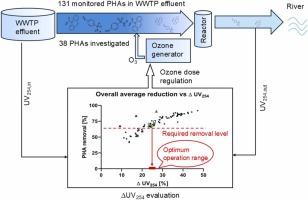Long-term application of ozonation for removal of pharmaceuticals from wastewater treatment plant effluent: Effectiveness, control strategies, ecotoxicity
IF 11.3
1区 环境科学与生态学
Q1 ENGINEERING, ENVIRONMENTAL
引用次数: 0
Abstract
This study presents the results of a seven-month testing of a pilot-scale ozonation system as a quaternary treatment of effluent from the WWTP in Blansko city (Czechia) with a focus on real-time control of ozonation technology based on the measurement of UV absorbance at wavelength 254 nm (UV254). The study investigated the effect of ozonation on 38 pharmaceuticals (PHAs) that were commonly found in Blansko WWTP effluent. Moreover, the method of ensuring a stable reduction of selected watchlist of PHAs in fluctuating conditions was investigated by evaluating UV254. During testing, an ozone dose of 0.8 mg O3/mg TOC was sufficient to reach 80 % overall removal of all investigated PHAs on average. It is necessary to mention that this sufficient dose only applies to the investigated set of pharmaceutical substances and might differ significantly for other sets of pharmaceuticals or different locations. The use of UV254 absorbance and its relative decrease during ozonation correlated to a stable and reasonably accurate monitoring of the actual level of PHAs removal of investigated/targeted PHAs. Estimating actual levels of reduction of evaluated substances in routine operation will significantly simplify operation, reduce the costs of analytical analyses and ensure compliance with required limits.

臭氧氧化法去除废水处理厂废水中药物的长期应用:效果、控制策略和生态毒性
本研究介绍了对捷克布兰斯科市(Blansko)污水处理厂废水进行为期七个月的四级处理的中试臭氧化系统的测试结果,重点研究了基于波长254 nm (UV254)的紫外线吸收度测量的臭氧化技术的实时控制。本研究考察了臭氧氧化对布兰斯科污水处理厂出水中常见的38种药物(pha)的影响。此外,通过对UV254的评估,研究了在波动条件下确保PHAs观察列表稳定减少的方法。在测试过程中,0.8 mg O3/mg TOC的臭氧剂量足以使所有研究的pha平均达到80% %的总去除率。需要指出的是,这个足够剂量仅适用于所研究的一组药物,对于其他药物组或不同地点可能有很大不同。UV254吸光度的使用及其在臭氧化过程中的相对降低与稳定且合理准确地监测所研究/目标pha的实际去除水平相关。在日常操作中估算评估物质的实际减少水平将大大简化操作,降低分析分析的成本并确保符合要求的限值。
本文章由计算机程序翻译,如有差异,请以英文原文为准。
求助全文
约1分钟内获得全文
求助全文
来源期刊

Journal of Hazardous Materials
工程技术-工程:环境
CiteScore
25.40
自引率
5.90%
发文量
3059
审稿时长
58 days
期刊介绍:
The Journal of Hazardous Materials serves as a global platform for promoting cutting-edge research in the field of Environmental Science and Engineering. Our publication features a wide range of articles, including full-length research papers, review articles, and perspectives, with the aim of enhancing our understanding of the dangers and risks associated with various materials concerning public health and the environment. It is important to note that the term "environmental contaminants" refers specifically to substances that pose hazardous effects through contamination, while excluding those that do not have such impacts on the environment or human health. Moreover, we emphasize the distinction between wastes and hazardous materials in order to provide further clarity on the scope of the journal. We have a keen interest in exploring specific compounds and microbial agents that have adverse effects on the environment.
 求助内容:
求助内容: 应助结果提醒方式:
应助结果提醒方式:


